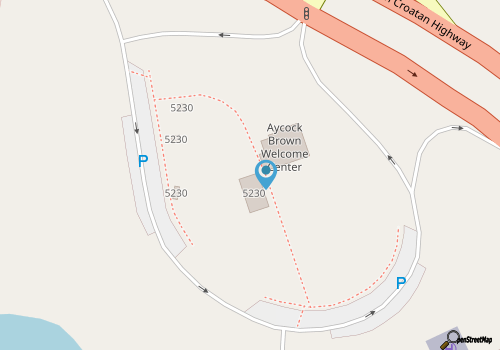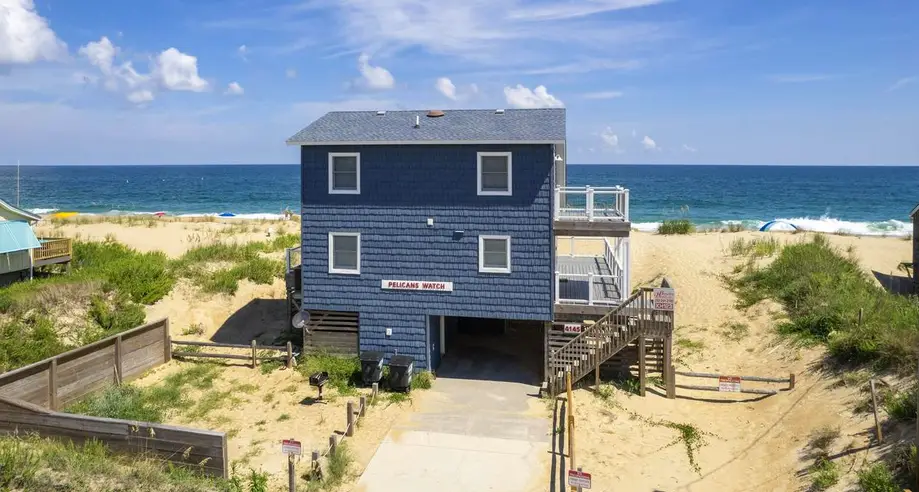The Aycock Brown Welcome Center greets vacationers coming south across the Wright Memorial Bridge along US 158, and is one of the first local attractions for visitors to the Outer Banks to explore, located at Milepost 1 in the town of Kitty Hawk.
The building itself is expansive, charming, and quintessentially coastal, and is inspired by the historic light saving stations that were stationed along the coastline, as evident by its gray, cedar shaked exterior, and tall "look-out" tower that just peeks over the top of the building. It's also reminiscent of the classic Outer Banks beach cottages with weather-worn shingles and sprawling wraparound porches complete with white wooden rocking chairs.
Here, tired travelers will find an ideal introduction to the Outer Banks, beginning with an ample parking lot, picnic tables, public restrooms, and comfortable outdoor seating to take a well-deserved break from the road.
Inside, the Aycock Brown Welcome Center is a treasure trove of area information, and visitors will find hundreds of pamphlets on local attractions and activities, area menus, vacation rental and real estate catalogs, and local guide books. In addition, the Visitors Center offers dozens of coupons and coupon booklets for Outer Banks vacationers, making it an attractive first-stop after arriving on the OBX for visitors who love a good bargain.
Visitors will also find assorted small souvenirs and apparel for sale, such as official Outer Banks T-Shirts, caps, and stickers. Best of all, the Aycock Brown Welcome Center is staffed with trained experts who are specialists in the area and can answer any visitors' questions from where to go golfing, to where the public beaches are located, to how long it takes to get to all four Outer Banks lighthouses.
The center itself, in fact, is named after the area's first tourism expert and area guide, Aycock Brown, the original director of the Outer Banks Tourism Bureau.
Aycock Brown enjoyed a long career as a coastal North Carolina writer, publicist, and particularly a photographer. In fact, Brown estimated that during the length of his approximately half-century career, he took over 100,000 photos of the Outer Banks and surrounding areas, many of which can still be viewed at the Outer Banks History Center, or at other local or regional archives.
After studying Journalism at Columbia University, Brown began his career in the 1920s and 1930s exploring and documenting the quiet coastal regions of Beaufort and Atlantic Beach, NC. At the time, these areas were mildly popular beach and tourist destinations, although the outlying areas and barrier islands were the biggest attractions to Brown, and he soon moved to Ocracoke Island to continue his wild explorations and subsequent writing and photography.
Many of his photos and articles landed in the regional or national spotlight, (including several Our State Magazine features), and eventually, Brown moved to Manteo where he took on the position of being the Outer Bank's very first Tourism Director in 1950.
Remember that during the early 1950s, the Outer Banks was still relatively undiscovered, with only a cluster of beach-goers hitting the main beach towns of Nags Head, Kill Devil Hills and Kitty Hawk, and fewer still making the sandy 4WD oceanside trek to the nearly deserted Currituck and Hatteras Island beaches.
As the tourism director, Brown made sure that the Outer Banks was known on a national level, and he spent the next 20 years submitting press releases, photos, and articles to local and national newspapers along the coast. He also kept steady hours at his office in Manteo with his staff so he could answer incoming calls and letters from curious visitors requesting more information about an OBX vacation.
As a result of his efforts, the attraction of the Outer Banks to new visitors slowly began to grow, and more and more people began to trickle to the beaches to enjoy the sun, fun and local attractions. By 1970, as Brown celebrated his 20 year anniversary as the Outer Banks Tourism Bureau Director, more than 7,000 letters and 1,000 telephone calls were piling into his Manteo office with questions about the area.
Inquiries ranges from the common, (which are still popular questions today), like where to stay, where to surf, or where to fish, to the not-quite-as-common. For example, Brown received one inquiry from a potential visitor who wanted to rent a lighthouse for a week, and another looking for a local taxidermist that could prove them with a large stuffed turtle. There was even a period of time when national rumors swarmed about a lost, sunken city that was located off the Outer Banks coast, and Brown responded to hundreds of letters questioning the city's validity, or more often, asking where to find it.
Through it all, Brown answered every query with professionalism and a smile, and as a result, his early efforts created the Outer Banks that visitors know and love from hundreds of miles away. (After all, in just about every town along the East Coast, there are a dozen vehicles sporting a variation of the popular "OBX" Euro sticker.)
In fact, it's really quite fitting that one of the first sites that all northern travelers encounter after they finally land on the Outer Banks is the Aycock Brown Welcome Center. Named after the man who originally inspired tourism on the Outer Banks, the Aycock Brown Welcome Center is the modern locale for vacationers from all over the world to obtain area information, have their questions answered, and enjoy a warm welcome to their OBX beach vacation.
Is this your business? Update your listing by messaging us
Sandy Run Park leads its visitors through the heart of Kitty Hawk Woods Coastal Preserve, one of the largest maritime forests remaining in North Carolina. Completed in two phases, the park now encompasses 1600 acres of marshland, waterways and...
The occasional rainy day won't interrupt a Kitty Hawk vacation, thanks to the many activities, attractions and sites that are found throughout the Outer Banks. If the raindrops fall, take advantage of these rainy day activities that are sure to keep...
Located in Kitty Hawk/ 3 Bedrooms/ 2 Full BathroomsImagine waking up to the sounds and smell of the ocean. Getting up early to watch an striking Outer Banks sunrise from your deck. Walking out onto the deck from the living area and your view is the...




